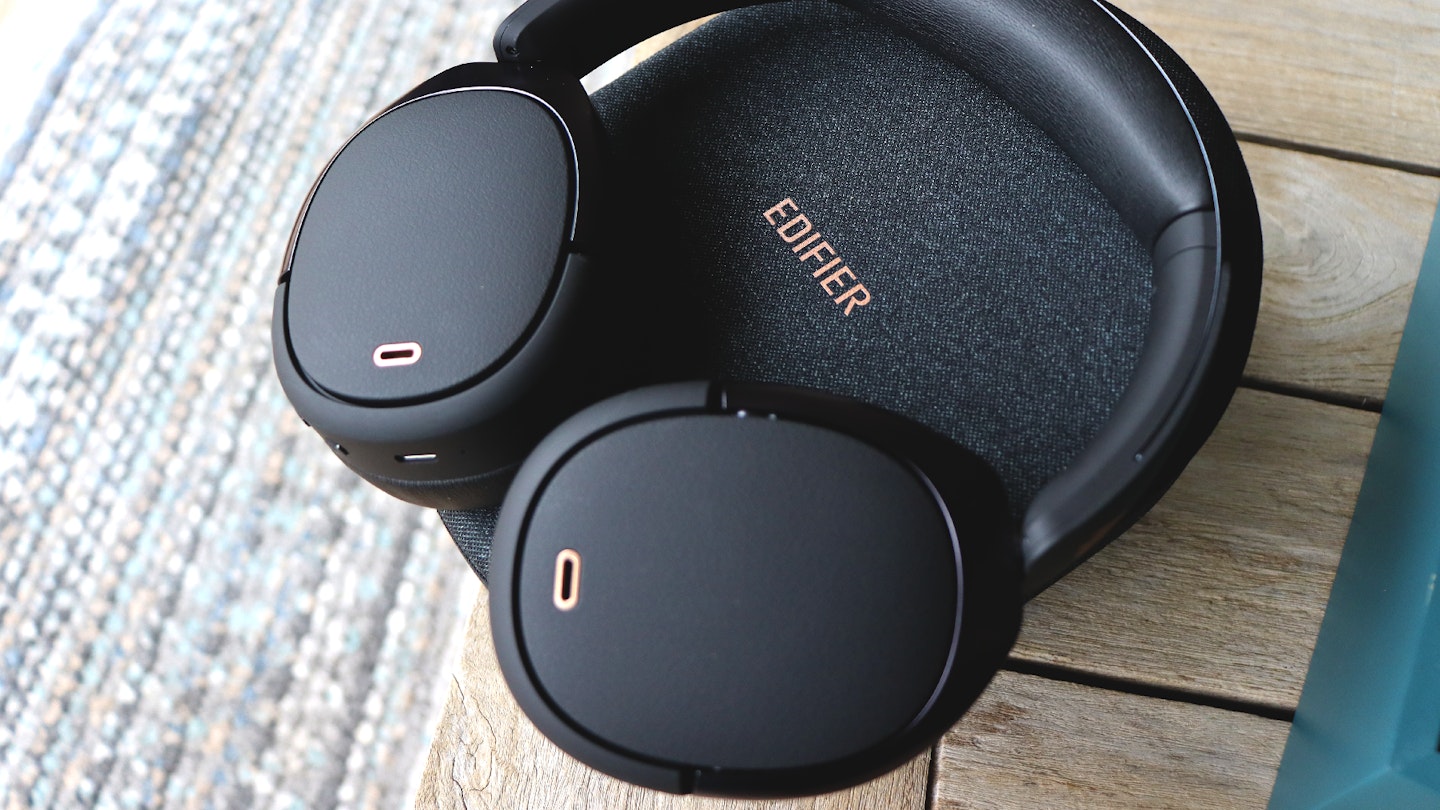Around since the late 1990s, Edifier are certainly no stranger to the world of high-quality audio - but can the Edifier WH950NB headphones really compete with the likes of Sony? After all, anyone looking for a pair of the best headphones will quickly find themselves looking at plenty of price tags over £300; particularly if those premium cans are packing Active Noise Cancellation. However, these Edifiers appear to combine a premium look, advanced Hybrid ANC, Hi-Res audio and great battery life into a product that sits comfortably below the £200 mark.
In our never-ending quest for the best of the best, we've enlisted our Tech Product Writer Chris Duffill to put the Edifier WH950NB headphones through their paces. Edifier's marketing material makes some sizable claims, most notably bold and crisp Hi-Res audio, effective elimination of background noise, and crystal clear voice calls. We've seen lots of big claims from audio companies before - particularly around wireless headphones. So, at around £170, is it really possible for this new set of cans to successfully tick so many boxes?

Pros
- Excellent Hybrid Active Noise Cancellation with various modes
- Comfortable over-ear fit for longer listening sessions
- Fast and easy automatic switching between two connected devices at once
- Excellent mics for voice calls
Cons
- No AAC support for Apple devices
| Driver: | 40mm dynamic driver with treble up to 40kHz |
| Connectivity: | Bluetooth 5.3, wired 3.5mm |
| Companion app: | Edifier Connect |
| Playtime: | 55 hours (no ANC), 36 hours (with ANC) |
| Extra features: | High-Res audio and LDAC codec, Folds flat in the case for portability, Fast Charging - 10 minutes for 7 hours of battery life, advanced ANC algorithm with various modes including Ambient, 4 environmental noise cancelling microphones, charging cable, carrying pouch, airplane audio adapter |
| Weight: | 721 Grams |
| Dimensions: | 19.3 x 16.9 x 8.2 cm |
- Customer review: "I can vouch for these and tell you they are not only fantastic for me, extremely comfortable, noise cancelling is decent and the microphone is the best I've found in this price range. The audio can be a little bassy in default but that can easily be adjusted in the app."
Performance
Setting up
The packaging of the Edifier WH950NB headphones is on-point. Inside there's fabric-covered clamshell pouch sporting the Edifier logo - a touch of class that would seem to signal inner quality. And, inside, the neatly folded headphones seem to deliver on that promise. They’re reassuringly heavy but not unwieldy to handle or wear. There’s a short USB charging cable and a 3.5mm cable with a dual mono adapter for airplane listening included too. After a 1-hour charge to top them up, I powered them on and they immediately attempted to pair via Bluetooth. A few seconds later and my iPhone was connected and I was listening to music.
The instruction booklet is probably the size of a large postage stamp. So, anyone with less than perfect vision will need to Google the manual or use a magnifying glass. Thankfully though, the instructions are minimal - and that’s all you need. It’s easy enough to simply use the device and discover everything it’s capable of.
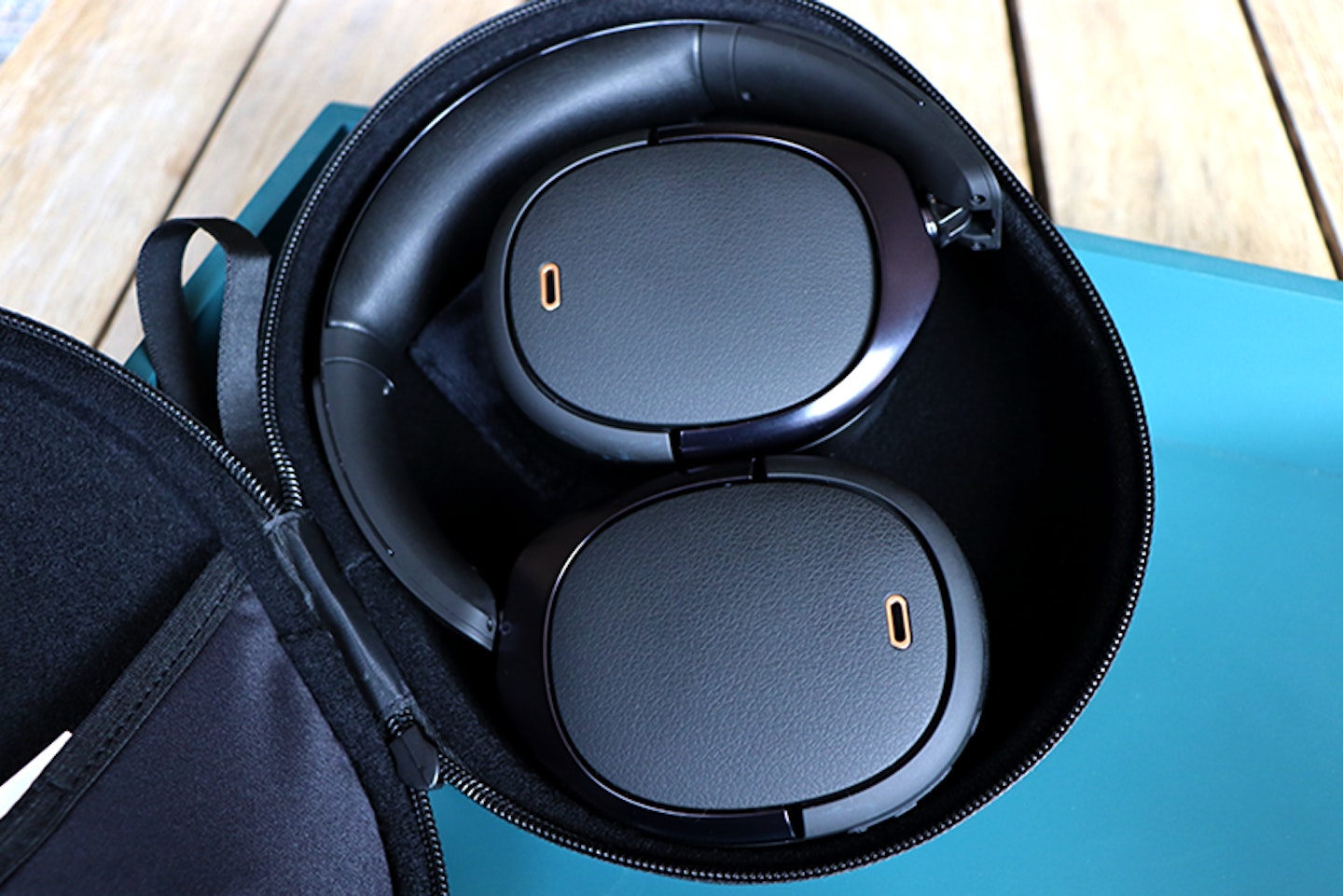
The sound
Apple Music and Spotify Premium
There's no doubt that, right off the bat, these impressed me. The soundstage is convincingly wide yet well-contained. Unlike some that over-reach themselves in pursuit of bigger sound, these headphones know their limits - and they're better for it. They also claim a 40kHz top-end that I was eager to hear.
Listening to Panama by Van Halen first, I found the range of these Edifiers to be right on the money; and the quality only improved the louder I got (bearing in mind that these have a rather wise upper limit of 85dB). I followed this up with a change of genre and tempo with with Lullaby by The Cure. Here the lead guitar really did sound crisp without losing any depth, surpassed in clarity only by Robert Smith's haunting vocals on that track.
All in all I never found like I had to reach for the Edifier Connect app EQ settings, or the onboard EQ presets. Instead, I left this set to ‘Music’. None of the tracks I listened to were lacking the depth and range I was used to from normal listening. Lastly, I played The Imperial March from John Williams’ score for Star Wars: The Empire Strikes Back. Without any bass guitars or thumping drum solos to plaster over the cracks, this is where I expected any shortcomings to really show up. The highs of the strings really were crisp and detailed. When the lower woodwind instruments made a showing, they also had a satisfying resonance and were cleanly defined.
High-res audio via LDAC
One of the key features of the Edifier WH950NB headphones is their certified support for high-res audio. And this is where I hit a small stumbling block: Apple devices don’t support the LDAC codec. That means that the higher bitrates of high-res audio streams would be unsupported on my phone.
So, having commandeered a Google Pixel 3XL, I connected to and began listening. As something of a sceptic when it comes to high-res formats on non-audiophile gear, these really were an ear-opener. Listening to Rider's On The Storm by The Doors on Apple Music and then switching to the same track played via Spotify, the former was clearly superior. Not that standard Spotify Premium is overly compressed, but the LDAC-delivered version was just, well, fuller-bodied.
Movies and TV
Rather than hitting Netflix right away, I chose Plex to locally stream movies and shows via my home network. As I have Plex set up to stream directly without any recompression, this was a good way to test surround sound right from the source while keeping things wireless. Using the Edifier’s Theatre Mode EQ preset gave everything a bit of an unexpected boost; Not out of this world, but just that little more resonance.
I can recommend these to anyone who doesn’t have a full home cinema speaker setup; your TV speakers alone aren’t going to compete with the Edifiers. Watching late at night is where the true power of these headphones lie. Not wanting to wake anyone else up while still enjoying a loud and immersive soundtrack is a true bonus here. Just don't do what I did and watch The Haunting of Hill House on your own at night with full ANC on...
Gaming
Once again connected via my TV, I selected the game mode on the Edifiers. I didn’t know what to expect, but according to Edifier this will lower the connection latency to around 8ms. That’s not lightning fast in gaming terms, at least where controllers and monitors are concerned, but for audio it’s imperceptible. I have to assume that this mode defeats the high-res audio codec support which would otherwise increase audio lag. Sound wise, Starfield has never sounded better. Working in tandem with ANC, it was definitely a more immersive experience. I noticed a lot of detail to the more incidental sound effects in the environment.
Calls
Making and taking calls while using these was a real pleasure. Quality was clear at either end of the call. Reportedly, those four noise-cancelling mics make for a clean connection which allowed a sensible amount of background noise. Even making audio calls using WhatsApp was much better than when simply using the phone itself. That’s somewhat to be expected, but even compared to other in-ear and over-ear headphones I’ve used, these performed really well.
Hybrid Active Noise Cancellation
These headphones do ‘no sound’ elegantly too, thanks to the Active Noise Cancellation feature. The modes cycle between High Noise Cancellation, Ambient Sound, and Off. The former is the most impressive. It uses external and internal microphones to monitor ambient noise, filter it out and then pipe music to your eardrums. This hybrid between inner and outer monitoring essentially means the system is always able to compare what it thinks it's giving you and what it actually heard inside.
In practice I found the ANC to be extremely effective, with all but the loudest of barks from my dog and the odd door slam being reduced to nothing, or close to nothing. Venturing outside without any music playing, close traffic noise was decimated, and other general environmental sound was pretty much non-existent. But, activating the Ambient Sound setting is useful too, as it'll let you listen in to surrounding noise without that 'underwater' effect that you get with non-ANC headphones. That's particularly useful during calls too.
Once again, the vocal notification when changing ANC settings is clear and not too loud. It's much better than those wireless noise cancelling headphones that use a mixture of beeps or tones with easily-forgotten meanings.
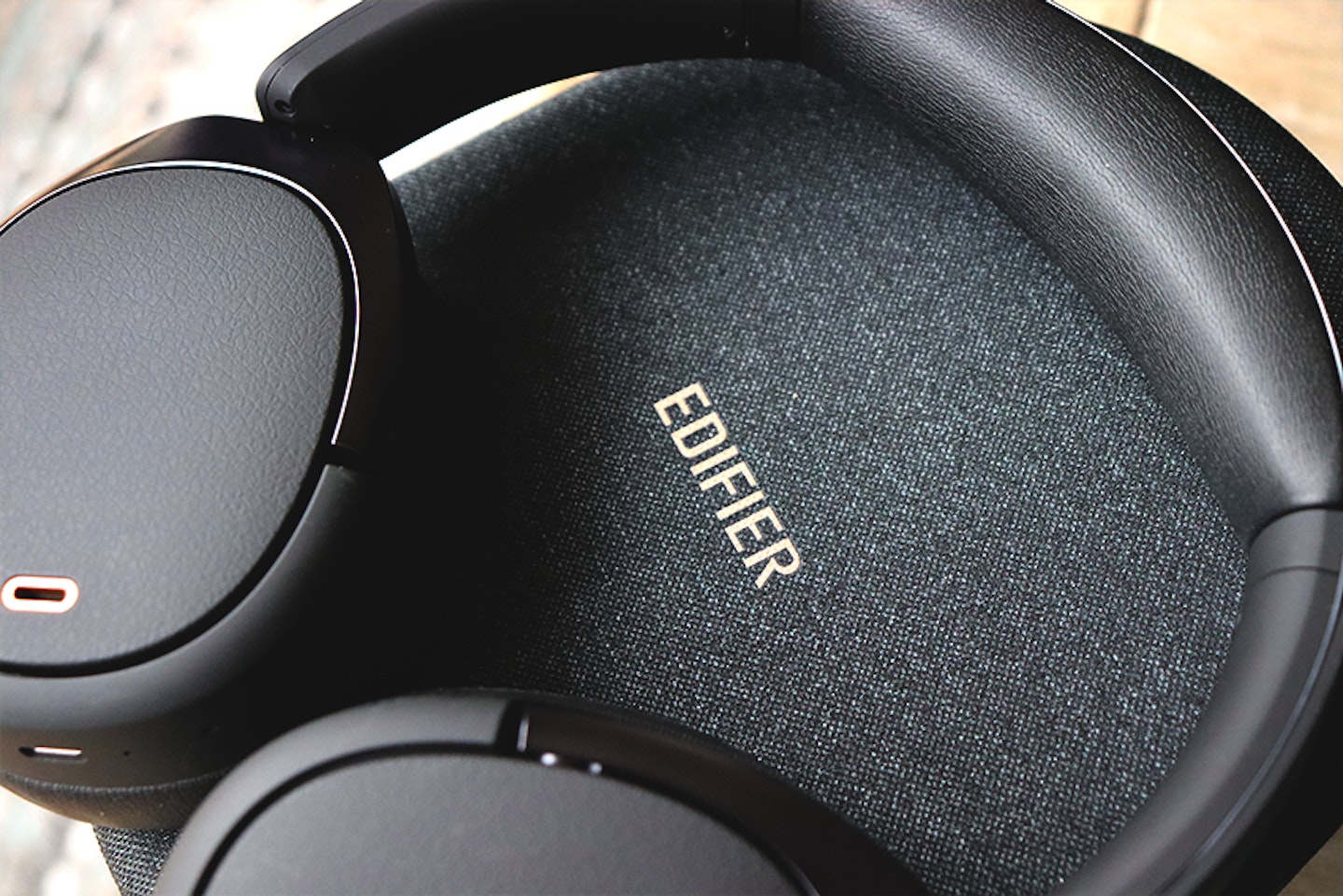
The controls
At the computer I found myself wanting to keep my right hand on the mouse and reach up with my left to tweak volume or pause playback. But all of the controls on the Edifier WH950NB headphones are on the right earcup. Not a huge issue, and the rubberised buttons are quite easy to find and identify by touch. A nice touch is the simplicity, with each of the four buttons being multifunction. For instance, a long press of the volume up button will skip tracks, and doing the same on the play/pause button will turn the headphones on or off. Long-pressing the on button will make them enter pairing mode. Single presses on the Mode button will cycle between the ANC modes. Double presses will switch the EQ preset modes.
I was also pleasantly surprised by the headphone’s ability to maintain two active Bluetooth connections and automatically switch between them based on the most recently used device. And it does this quickly too, for a more or less seamless experience. Hitting play on Spotify on my iPhone, and then playing a YouTube video on my iPad resulted in a short delay between the audio switching to match. So, no clumsy re-pairing or annoying connection beeps to ruin the experience.
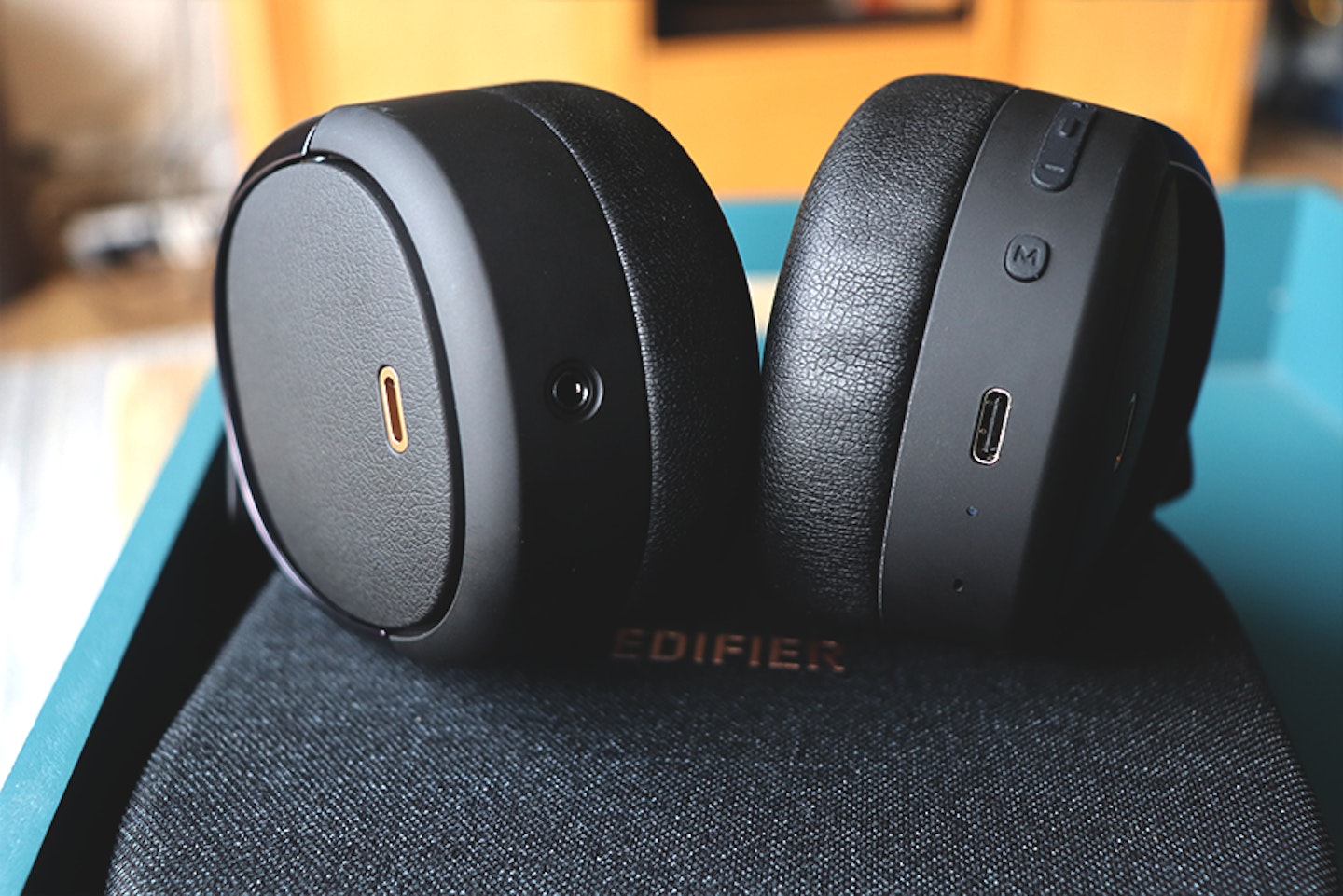
Design and build
The materials used on the cans themselves are a hard casing with a nice soft touch to the finish. They're both reassuringly solid, but not so weighty as to shift around or become uncomfortable. The headband is polished machined dark metal - it likes fingerprints but am happier with this minor downside over the usual plastic bands. There is a white version too, if you like the Apple or Beats aesthetic, but I prefer the more traditional black finish.
The fit
Build is solid - somewhat reminiscent of some of the best Bose headphones I've seen. The metal strip on the headband is sturdy - I did have to gently flex it for a comfortable fit, but then again I even find it hard to get glasses that fit; so that's more to do with my impractical noggin than anything else. Thankfully, the Edifiers aren't uncomfortable over long periods and the pads are clearly nice and breathable too. They were even comfy enough to wear while fully reclined - the only danger being falling asleep thanks to the brilliant noise isolation.
Range and battery life
Charging the Edifier WH950NB headphones was fast and it will last something close to the stated 36 hours with ANC turned on. They also support fast-charging and I can vouch for the stated ability to charge for around 10 minutes and give around 7 hours of playback from it. A one hour charge gave me the full 55 hours (no ANC) too. Bear in mind though, to monitor your remaining charge you'll need the Edifier Connect App as there's no on-board method of doing this.
The range of these when connected to my iPhone was very impressive compared to other headphones I’ve tested. This is probably in-part due to the Edifier's use of Bluetooth version 5.3 which not only has increased bandwidth necessary for high-res, it also has increased range. I was reliably able to continue to listen without the dreaded breakups from signal loss in the garden, with my phone left languishing on my desk over 25ft away.
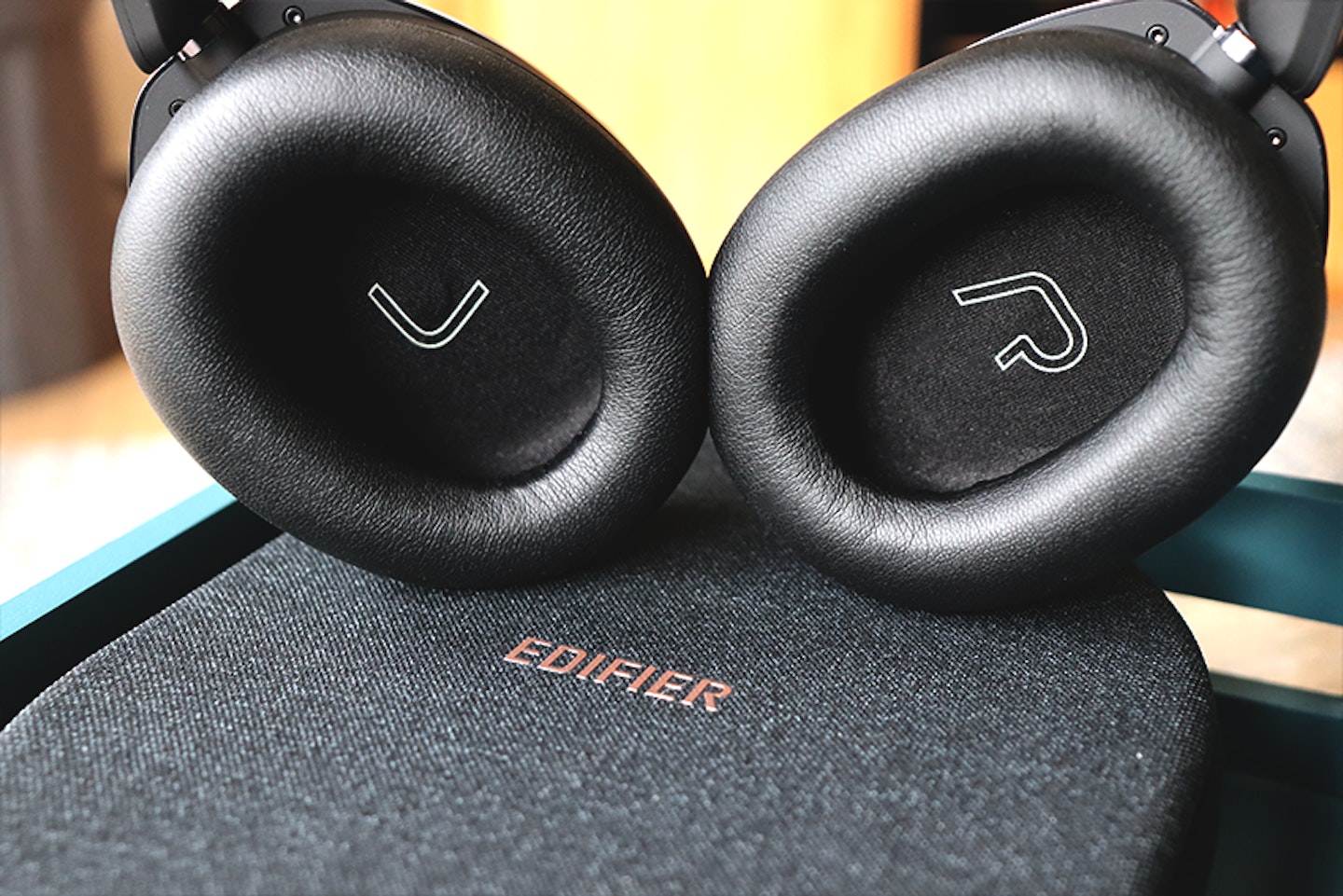
Any downsides?
Whilst the controls on the right speaker are easy enough to find, the volume down button has an indented minus symbol on it. This can often be a little hard to find, as the play/pause button and volume-up buttons are raised instead. I found my fingertip would find the larger of the two and glide over the volume-down button and find the mode button instead. But, I did get more used to this over time.
The charge cable is very short at around 14-inches long. It’s a USB 2.0 to USB-C connector and no charging plug is provided. I understand the latter for limiting e-waste and other environmental reasons, but I do wish the cable was a more practical length. Luckily for me, I have a desk with a USB hub within easy reach, but when taking the Edifier’s away with me things are not so convenient. I managed to find a socket close to a shelf which meant I could plug them in and keep an eye on the charging light.
Lastly, regarding those limitations of the iPhone mentioned earlier, currently all Apple devices don’t support the LDAC codec. Since LDAC is part of the high-res audio magic that’s happening here, the Edifiers are going to be of limited use for iPhone owners looking for high-quality sound. So, what’s the issue here? Well, I would have liked to have seen the Edifiers support AAC, which is a slightly better compression format over the others supported by the iPhone.
Price and competition
Needless to say, there are quite a few sets of over-ear headphones in the £100-£200 range. And you’ll have a lot of choice over how and where that money ends up; from sheer sonic performance to ANC and other technical features. But, for me, the Edifier WH950NB headphones have struck an ideal balance between all of the main areas that headphone fans are looking for. That said, when we reviewed the Huawei FreeBuds Studio headphones we found that they were also consummate performers with some good ANC options, and for almost the same price. And if you want over-ear headphones and have a little more cash to splash, you can’t go far wrong with the Sony WH-1000XM4 headphones that have a great reputation for clarity and satisfying bass.
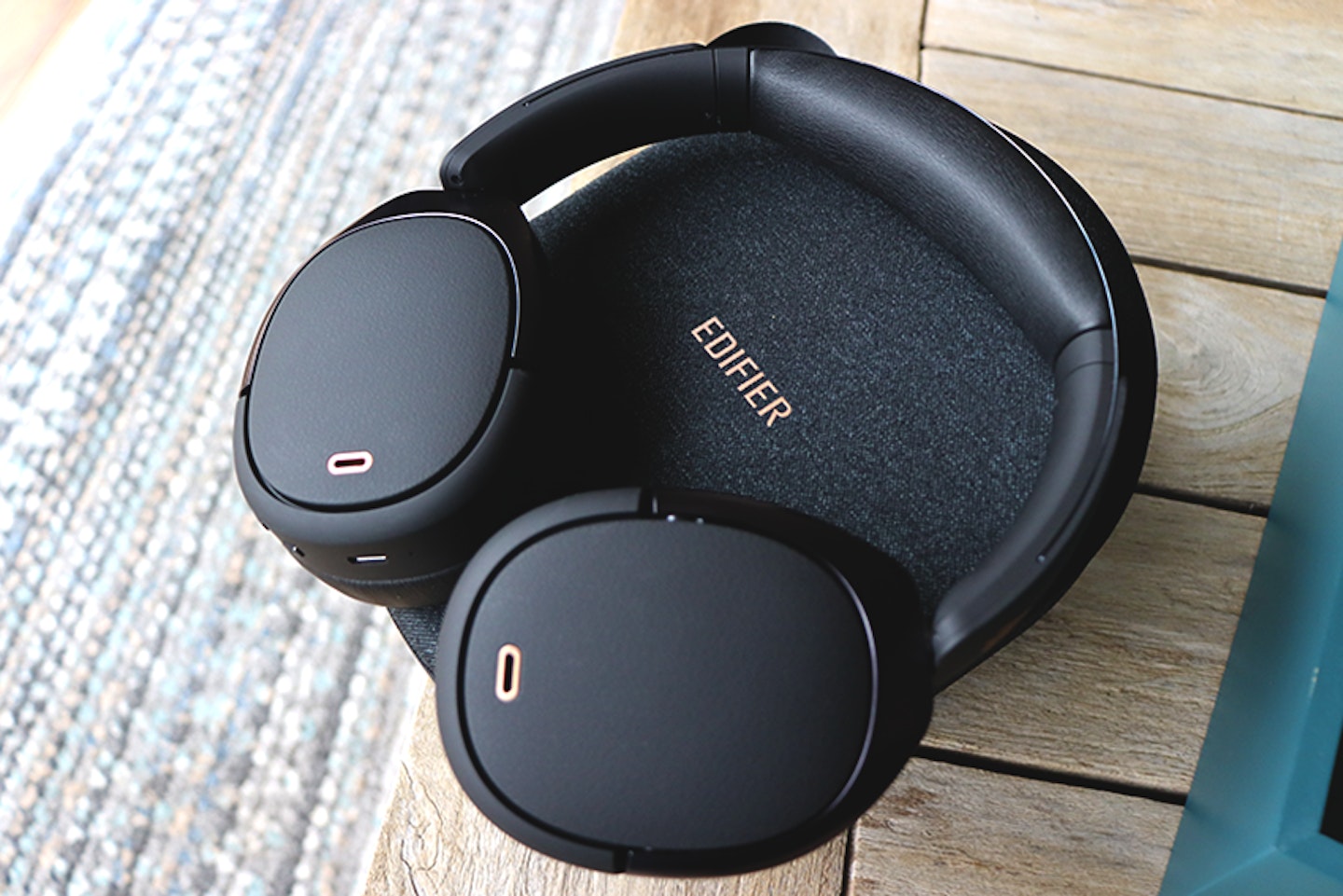
Verdict
While I’m sure that some others will crave slightly better (and more expensive) ANC features and skull-shattering bass, for my taste the Edifier WH950NB headphones were excellent all-rounders with a more than satisfying range and depth. I never found myself wishing I could squeeze more bass or treble out of these, and the soundstage was wide enough but precise. I was able to enjoy music of all genres and never find myself feeling like the definition was getting muddied, particularly in the midrange.
These headphones have also re-introduced me to the joys of watching movies with a pure sound isolated from the usual household noises. The ANC doesn’t get in the way and makes for a wonderfully pure listening experience with everything from music to phone calls. For the asking price, I think the Edifier WH950 headphones are a tough act to follow.

Pros
- Excellent Hybrid Active Noise Cancellation with various modes
- Comfortable over-ear fit for longer listening sessions
- Fast and easy automatic switching between two connected devices at once
- Excellent mics for voice calls
Cons
- No AAC support for Apple devices
| Driver: | 40mm dynamic driver with treble up to 40kHz |
| Connectivity: | Bluetooth 5.3, wired 3.5mm |
| Companion app: | Edifier Connect |
| Playtime: | 55 hours (no ANC), 36 hours (with ANC) |
| Extra features: | High-Res audio and LDAC codec, Folds flat in the case for portability, Fast Charging - 10 minutes for 7 hours of battery life, advanced ANC algorithm with various modes including Ambient, 4 environmental noise cancelling microphones, charging cable, carrying pouch, airplane audio adapter |
| Weight: | 721 Grams |
| Dimensions: | 19.3 x 16.9 x 8.2 cm |
- Customer review: "I can vouch for these and tell you they are not only fantastic for me, extremely comfortable, noise cancelling is decent and the microphone is the best I've found in this price range. The audio can be a little bassy in default but that can easily be adjusted in the app."
More items to consider
Best alternative to Edifier WH950NB for price

With a combination of well-executed controls, precision audio and effective ANC modes, the Huawei FreeBuds Studio makes a very neat package. It's Bluetooth cannot instantly reconnect with devices however, and the app support is a little flaky. They do, however, perform very well and the design is sturdy yet comfortable.
Pros
- Precise audio
- Effective ANC
- Nice design - smart, understated
- Light but sturdy build
Cons
- Average battery
- Occasionally temperamental initial Bluetooth connection
| Driver: | 40mm, four-layer polymer |
| Connectivity: | Bluetooth 5.2 |
| Companion App: | Yes |
| Playtime: | 24 hours (no ANC) |
| Extra features: | ANC, hear-through, touch controls, wear detection |
| Weight: | 260g |
| Dimensions: | 19.4 x 15.2 x 8.15 cm |
- Customer review: "They look great and sound even better. Comes with its own protective case. Would definitely recommend"
Best alternative to Edifier WH950NB for ANC

If you can push your budget a little higher, the Sony WH-1000XM4 also has detailed audio full of life and vibrancy. The feature set is strong and well-implemented as you'd expect from the best Sony headphones. They have touch controls, multi-device connection and cutting-edge distraction-silencing noise-cancellation. That said, we're not sure whether they offer much more than the Edifiers for the extra spend. However, the earpads are well-padded, and the battery runs for 30 hours.
Pros
- Excellent audio quality from Sony
- Great features including industry-leading ANC
- Nice battery playtime
Cons
- Is now slightly out of date technically
| Battery life: | Up to 30hrs |
| Charging: | USB-C, full in 3hrs |
| Connection: | Bluetooth 5.0, Aux |
| Weight: | 250g |
- Customer review: "Sony uncovers everything you have to create perfection, or almost. If the previous version, the 1000XM3 dethroned the Bose QC35 from its throne, this time Sony puts everything on the table to stay. Although it's not easy, in recent years, both Bose and other brands have pulled out their active noise-cancelling headphones to take their piece of cake."
How this product was tested
I tested the Edifier WH950NB headphones for several hours a day for two weeks. They were primarily paired with an iPad Pro and an iPhone, as well as a Samsung smart TV. Sources included a range of genres from Apple Music, Spotify Premium and internet radio. Sound from TV and movies was locally streamed via the Plex TV app to avoid recompression. I tested high-resolution audio over an LDAC connection with a Google Pixel 3XL phone. Voice call was tested using an iPhone 8+, via the EE network, and through WhatsApp. Gaming performance was tested with Starfield running on an XBox Series X.
Chris Duffill is a Tech Product Writer for What's The Best. He specialises in audiovisual, computing, and gadgets. He also writes for Yours.
Subscribe to the What’s The Best Newsletter to keep up to date with more of the latest reviews and recommendations from the rest of the What’s The Best team.
